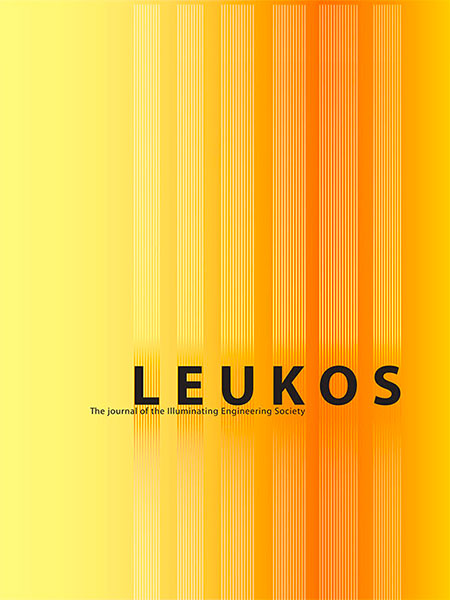A printed edition of all four online issues is scheduled each year for September availability and is provided to archival subscribers as part of their subscription fee. IES members, who receive free access to LEUKOS as a benefit of membership, may purchase this compilation issue at a cost of $25.00 ($40 from July 2023 on) by logging into their online IES membership account or order it on their annual dues renewal form. The four annual Internet issues make information available to general subscribers in a timely fashion. The printed compilation of all four issues is included with an institutional/non-member subscription and provides a record for libraries and others with archival requirements.
Click here for more information, to subscribe or purchase an article.

Aims and Scope
LEUKOS, the journal of the Illuminating Engineering Society (IES), is an international venue for technical developments, scientific discoveries, and experimental results of current interest or lasting importance in the applied use of light. Topics of interest include visual and non-visual responses to optical radiation, all aspects of the technologies employed in the generation, control, measurement, and computation of light and color, the lighting design of interior and exterior environments, and cross-cutting topics that include daylighting, energy management, economics, and sustainability. LEUKOS publishes several types of manuscripts:
- Scientific research results. Research results of significant and archival value in those scientific disciplines directly or indirectly related to light.
- Engineering developments. Reports on new or improved equipment, materials, processes, or systems used directly or indirectly in lighting, lighting equipment, or lighting design.
- Technical aspects of lighting applications. Technical aspects related to electric lighting, daylighting, lighting controls, standards and innovations in design.
- Tutorial articles or critical reviews. Summaries of a technical topic in lighting of general interest, written specifically for study and instructional purposes. Tutorials and reviews are meant for technically knowledgeable readers who are not specialists in the subjects treated.
- Brief communications. These are notes or short articles, of a technical nature that do not have the scope or extensive results of large studies or engineering projects but provide useful data, analyses, or information.
All submitted manuscripts are subject to initial appraisal by the Editor, and, if found suitable for further consideration, to peer review by independent, anonymous expert referees. All peer review is double-blind and submission is online via ScholarOne Manuscripts.
Editors
LEUKOS is edited by an Editorial Board of subject matter experts:
Dr. Ute Besenecker
Head of Division, Lighting Design
Dr. Siobhan Rockcastle
Dr. Cameron Miller
Dr. Manuel Spitschan
Chronobiology & Health
Germany
Dr. Minchen Wei
Dr. Sarah Haigh
University of Nevada, Reno
United States
Dr. Andrea Wilkerson
Journal Information
The Illuminating Engineering Society and publisher Taylor & Francis make every effort to ensure the accuracy of all the information (the “Content”) contained in our publications. However, The Illuminating Engineering Society and our publisher Taylor & Francis, our agents, and our licensors make no representations or warranties whatsoever as to the accuracy, completeness, or suitability for any purpose of the Content. Any opinions and views expressed in this publication are the opinions and views of the authors, and are not the views of or endorsed by The Illuminating Engineering Society and our publisher Taylor & Francis. The accuracy of the Content should not be relied upon and should be independently verified with primary sources of information. The Illuminating Engineering Society and our publisher Taylor & Francis shall not be liable for any losses, actions, claims, proceedings, demands, costs, expenses, damages, and other liabilities whatsoever or howsoever caused arising directly or indirectly in connection with, in relation to, or arising out of the use of the Content.
Please direct all questions to research@ies.org.
